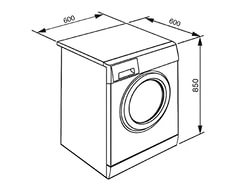What is Shiatsu drum in washing machine?
 It seems that with each new model, the inner walls of washing machine drums acquire more and more intricate “patterns”. If you look closely, you can really see various depressions, ribs, complex convexities, and so on. These elements play an important role in helping to remove stains from fabrics. The Shiatsu drum in the washing machine has benefited from this technology. What it is?
It seems that with each new model, the inner walls of washing machine drums acquire more and more intricate “patterns”. If you look closely, you can really see various depressions, ribs, complex convexities, and so on. These elements play an important role in helping to remove stains from fabrics. The Shiatsu drum in the washing machine has benefited from this technology. What it is?
About Shiatsu Technology
In fact, you shouldn’t expect any stunning effect from this new product. To notice the difference at all, you need to closely examine the drum from a special angle and in good lighting. Then a discreet shimmer will become noticeable on the inner surface. This is a special coating that makes the inside of the drum surface completely inert to any type of fabric.
What is it for? In conventional drums, synthetic fabric, when rubbed against a metal surface, becomes electrified and then sticks to the walls of the container. This leads to the fact that during spinning the fabric is subjected to strong friction and, as a result, is damaged, and its service life is noticeably reduced.
Tank and drum design
The drum is a cylindrical container made of stainless steel with many holes. One wall of the drum is missing and plays the role of a hatch through which clothes are loaded there. On the opposite side there is a threaded shaft that connects the container to the motor.
Inside the drum there are redans - plastic ribs, most often hollow inside. In some models, the redans are made with holes for better effect. Their task is to evenly distribute the laundry in the drum during washing, mix it and remove dirt, replacing friction with your hands.
The tank is another cavity that seems to cover the drum. If the drum is always made of stainless steel, then the tank can be made of either plastic or iron. Water and washing powder enter the drum cavity precisely by passing through the tank.
The tank is rarely a monolithic element. Most often it consists of two welded forecastles, which makes the structure disassemble. The drum and tank are connected to each other by a pulley. The tank itself is secured inside the washing machine using fixing springs located in the lower part of the body.
How is the drum constructed?
The drum of the washing machine is made only from stainless steel sheet. This choice is explained by the fact that this material is very durable, does not corrode and can withstand extreme operating conditions.
The holes on the inner surface of the drum are designed to allow water and detergents from the tank to easily penetrate into the cavity, and then the waste liquid is poured out. However, perforation, the official name for the surface, has a negative consequence. During washing, fabric fibers are damaged by the joints of the holes, and during spinning at high speeds they are drawn inward due to centrifugal force, which also harms the products.
Over time, washing machine manufacturers wondered how they could improve the surface of the drum so that the laundry would be subject to less wear and tear during the washing and spinning process. This is only possible if the contact of the fabric with the drum is minimized.
Most of the most commonly used washing machine drums can be classified into one of several types.
- Perforated drums. Those same drums with many holes that effectively wash things, but at the cost of some damage, which ultimately shortens the life of the products.
- Drip drums. Drums with droplet-shaped holes in the surface were first invented by Bosch washing machine manufacturers. The drops, although they have gentle sides, protrude quite strongly into the drum. As a result, when the drum rotates favorably, the laundry comes into contact with the sloping part of the drop and is less damaged, but when rotated in the opposite direction, it clings to a sharp protrusion.

- "Pearl Drums" This type of perforation is already more gentle. The holes in the drum are made in the form of hemispheres, reminiscent of a scattering of pearls of different sizes. As a result, the laundry comes into less contact with the holes and is less damaged.
- Honeycomb drums. This name has nothing to do with cell phones. In fact, it is related to the word honeycomb, since the inner surface of the drum is made in the form of convex hexagons. This shape of the protrusions protects the laundry from contact with the perforated part of the drum. Speaking of the holes themselves, they are very small, which, together with the honeycomb shape, minimizes damage to the laundry and also prevents foreign objects from getting into the drum.
The conclusion is simple: the more convex and “complex” the texture of the drum surface, the more gentle the wash. The smooth surface of the drum is not conducive to washing things, and the angular and rough texture damages the fabric.
Interesting:
Reader comments
- Share your opinion - leave a comment





















Add a comment